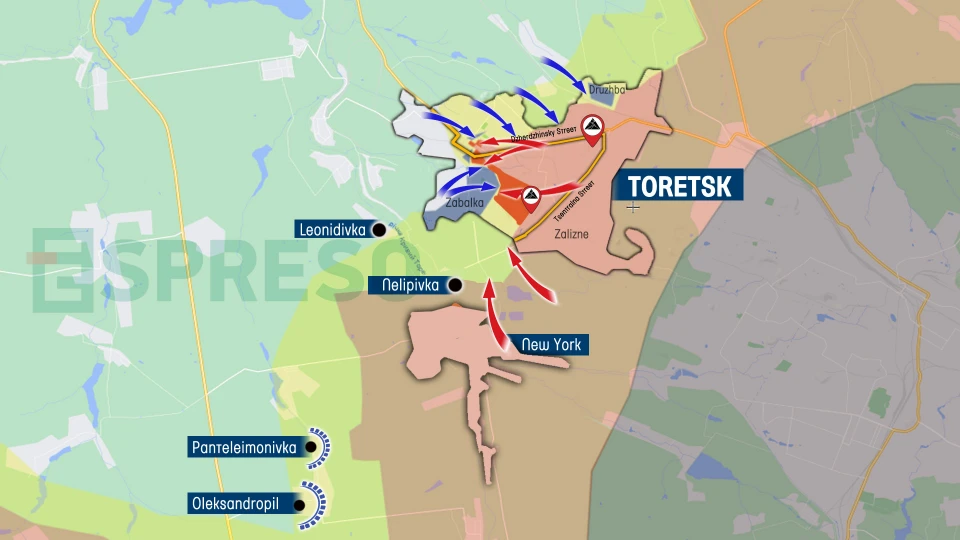
November 13–20 live war map: Triple threat on Kurakhove front and breakthrough in Chasiv Yar
The number of clashes on the front lines has dropped sharply, mainly because of the slowdown in the Russian offensive toward Kurakhove. Still, the Kurakhove and Pokrovsk directions together account for 60% of all Russian attacks. While Russia’s activity on the Lyman and Kupyansk fronts has eased, it has picked up in the Berdiansk sector. Despite fewer assaults overall, Russian forces have made notable gains in Chasiv Yar
A new threat in Velyka Novosilka
Russian forces are shaping a new front around Velyka Novosilka, striking both head-on and from the flanks. This week, they entered and attempted to secure positions on Makarivka's southern outskirts. Within days, however, Ukrainian forces reclaimed the area.
On the right flank, Russian troops completed their second capture of Rivnopil and pushed north of the village toward the Velyka Novosilka-Hulyaipole highway. In nearby Novodarivka, fighting raged in the village center all week. On the left flank, Russian forces gained several hundred meters northwest of Novodonetske.
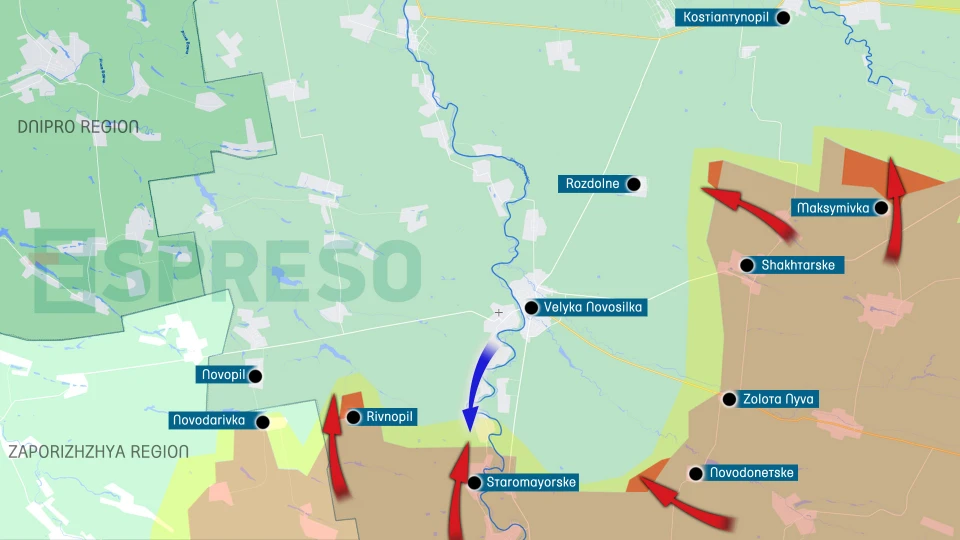
The most serious threat to Velyka Novosilka, however, comes from a Russian advance toward Rozdolne, positioned north of Ukraine’s fortified zone. A breakthrough here could allow Russian troops to outflank Ukrainian defenders. The defensive lines in Velyka Novosilka may not be prepared for an attack from this direction.
The Kurakhove front: Holding on, but facing encirclement
The Russian push near Kurakhove has slowed down significantly. Their forces are bogged down in battles and have made only minimal gains this week. Clashes have dropped by nearly a third, suggesting they can’t sustain the earlier intensity without reinforcements or regrouping.
After losing Maksymivka, Ukrainian forces stabilized the southern line further west, managing to hold back the Russian offensive on Sukhi Yaly.
However, a looming threat of encirclement has emerged on the eastern wing of the southern flank. While Ukrainian units are holding the line in Yelyzavetivka and Illinka, and fighting rearguard actions in Antonivka, Russians are advancing toward Uspenivka, aiming to cut off supply lines. The gray zone is now within 1.5 kilometers of Uspenivka—a key logistical hub. Losing this position would isolate Ukrainian brigades east of Dalne and Uspenivka, forcing a costly breakout under tough conditions. Although Ukrainian forces are cautiously pulling back from vulnerable areas, holding Trudove and the approaches to Uspenivka is critical. Any breach from the north — where Russian troops are pushing toward Illinka and Romanivka — would further complicate the retreat.
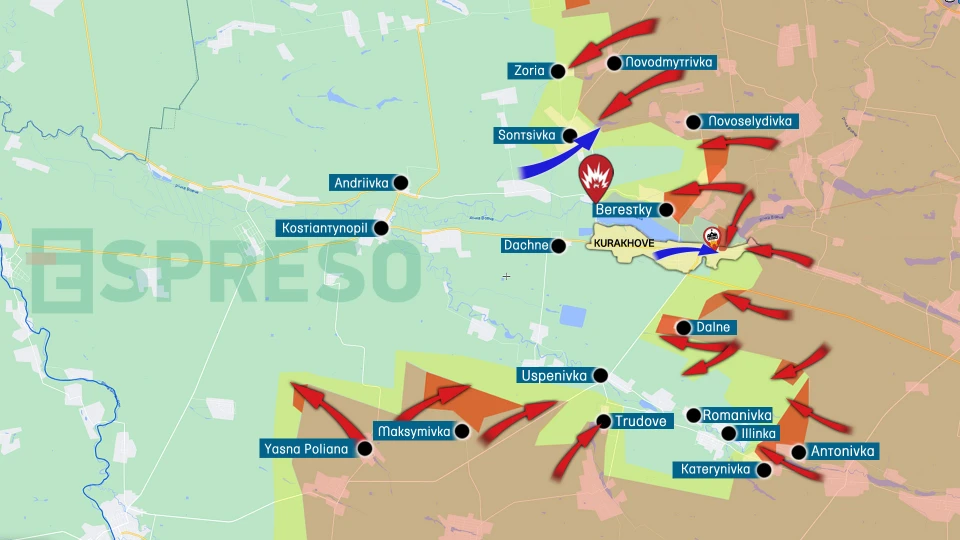
Meanwhile, the fight around Dalne has become a flashpoint. With Dalne nearly lost, Russian forces are poised to sever the Kurakhove-Uspenivka road and gain access to southern Kurakhove. Ukrainian forces must hold this ground at all costs. Russian forcess, aware of its importance, have intensified their attacks. Whether the southern front collapses or withdraws in an organized manner hinges on the battle here.
Fierce combat continues in the eastern part of Kurakhove, which has become a gray zone without clear control. Russian forces are particularly active near School No. 3, a contested site where Ukrainian soldiers have launched repeated counterattacks to push them out. Yet the occupying Russian troops keep pressing, especially from the north. With the Vovchansk reservoir dried up after dam explosions, Russian troops are using it as a passage for their attacks. As winter frost strengthens, Kurakhove’s northern defenses could become even more vulnerable, where Ukrainian forces are now withdrawing with battles.
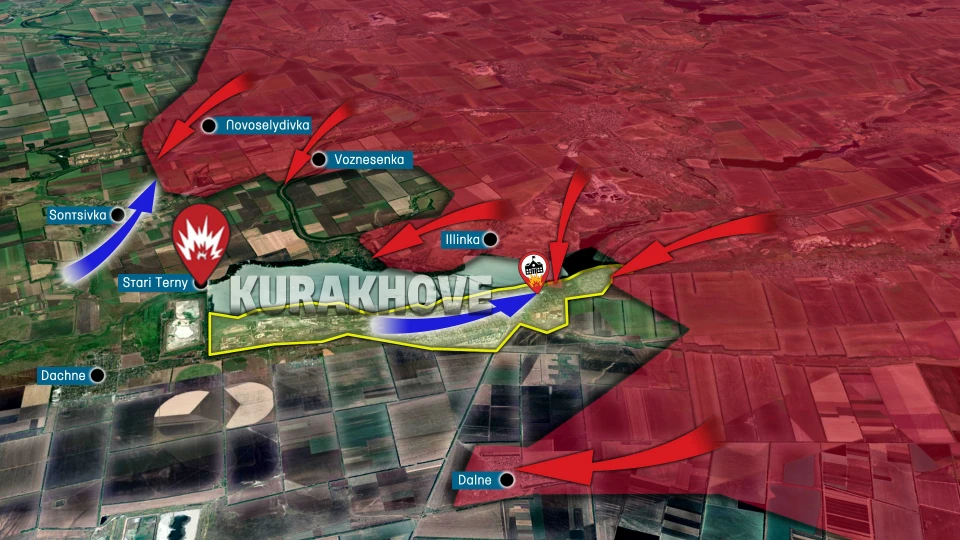
Ukrainian forces retook part of Sontsivka and established defenses there. In addition, they are containing Russian advances following the occupation of Voznesenka and Novoselydivka. These efforts have allowed Ukrainian troops to pull back gradually along the northern bank of the Kurakhove reservoir. Despite this, Russian forces have occupied Nova Illinka and parts of Berestky, where battles are ongoing. The northern flank’s front line now runs along a ridge from central Berestky northward. While the situation here seems more stable than the southern flank, it could ultimately lead to a phased Ukrainian withdrawal from Kurakhove. Recent developments, however, suggest that retreating from the city is not imminent — possibly not even this year.
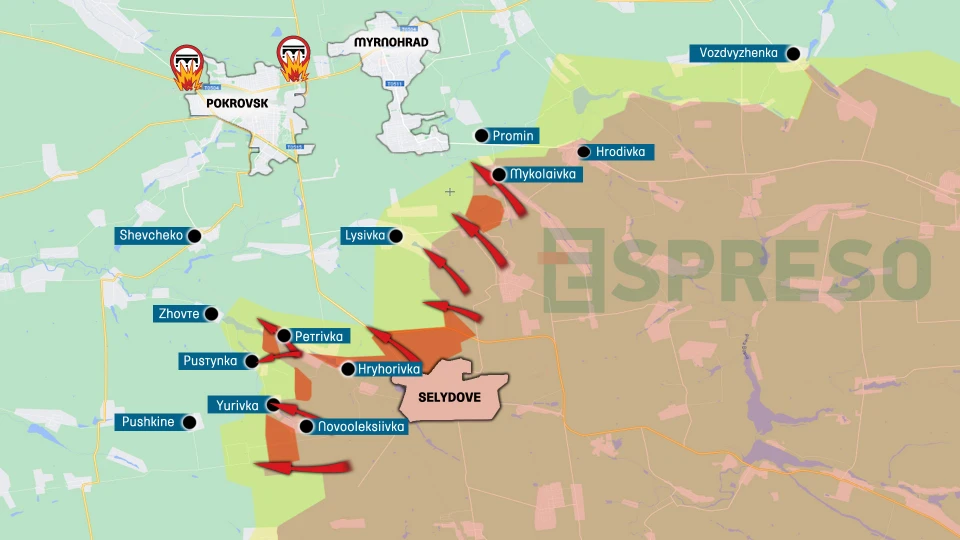
Pokrovsk barrier
Despite nearly 250 battles per week in the Pokrovsk area, Russian forces have made almost no progress. The front line remains stable, especially on the northern flank. On the southern side, Russian troops are probing for weaknesses in Ukrainian defenses to reach the road leading to Pokrovsk. They’ve made minor gains near Novooleksiivka, Yuriivka, and Pustynka, but their pace is nowhere near worth the scale of their losses. Their biggest “breakthrough” has been a 1.5 km advance along the Selydove-Pokrovsk road. Further north, they’ve managed to occupy the gray zone near the mine at Krutyi Yar.
Toretsk meat grinder
The Ukrainian Armed Forces are holding the central part of Toretsk, where Russian troops have been unable to break through. Ukrainian soldiers are also counterattacking in the northern parts of the city and its suburbs, though these advances don’t yet show up on the map, as every house is fiercely contested. Meanwhile, Russian forces are trying to flank Toretsk from the south, attacking from Nelipivka toward Leonidivka and Zabalka. To the east of Zabalka, Russian troops have reoccupied the forest park zone and advanced back to houses they were pushed out of a month ago. They’ve launched a new assault on Zabalka, slowly advancing through the area’s buildings. Currently, about 50% of Toretsk is under Russian control. If Zabalka falls, Ukrainian-controlled territory could shrink drastically.
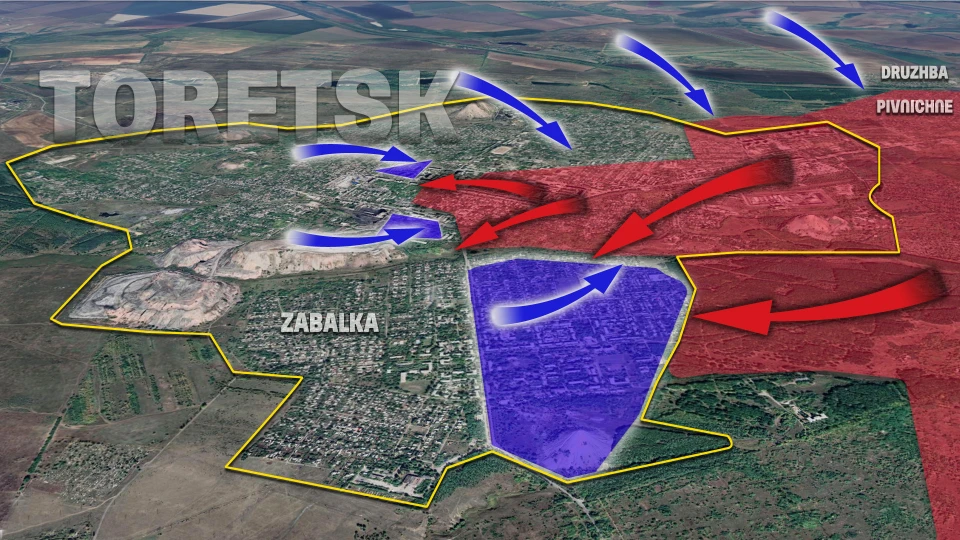
Russian forces break into central Chasiv Yar
The defense of Chasiv Yar has suffered significant breaches, which isn’t surprising given that the city has endured over a year of relentless bombardment, including with guided aerial bombs. South of the city, Russian forces have finally pushed Ukrainian troops back near Klishchiivka and Andriivka, positions that previously blocked their flanking maneuvers. Klishchiivka is now fully occupied, and the gray zone has expanded westward by 3 km to the Siversky Donets Canal and southward by 5 km, including Andriivka. Ukrainian forces are expected to withdraw to the canal’s right bank, abandoning areas reclaimed during the 2023 summer counteroffensive. The canal is shaping up to be the new defensive line.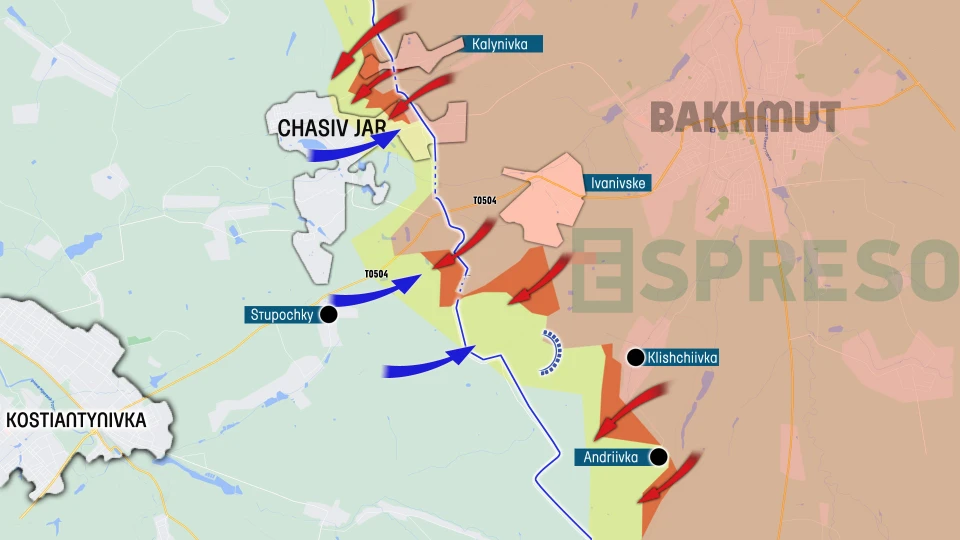
In Chasiv Yar itself, Russian forces have advanced into the Zhovtnevy district, occupying the northern part of the city. They’ve since pushed further, launching offensives in the central district, where intense fighting continues. Meanwhile, they’ve captured all of Kalynivka, connecting their northern and central positions. The fiercest clashes are now centered around the cultural center and the refractory plant. These battles will likely determine how long Chasiv Yar’s defense can hold. If the central part of the city falls, the situation will become much more critical.
Kupyansk repels paratroopers
In an unexpected move, Russian paratroopers, disguised in Ukrainian military uniforms, drove over 4 km along the road to Kupyansk without being stopped. They attempted to establish a position in one of the central districts on the left bank. But this stunt ended poorly for them — once discovered, they were either eliminated or captured. Ukrainian defenders also thwarted another attempt on the move. Despite these setbacks, Russian troops managed to inch closer to Kupyansk by over a kilometer within a week, securing part of the road from Lyman Pershyi and expanding their control zone. Even so, Ukrainian Defense Forces held firm in Synkivka.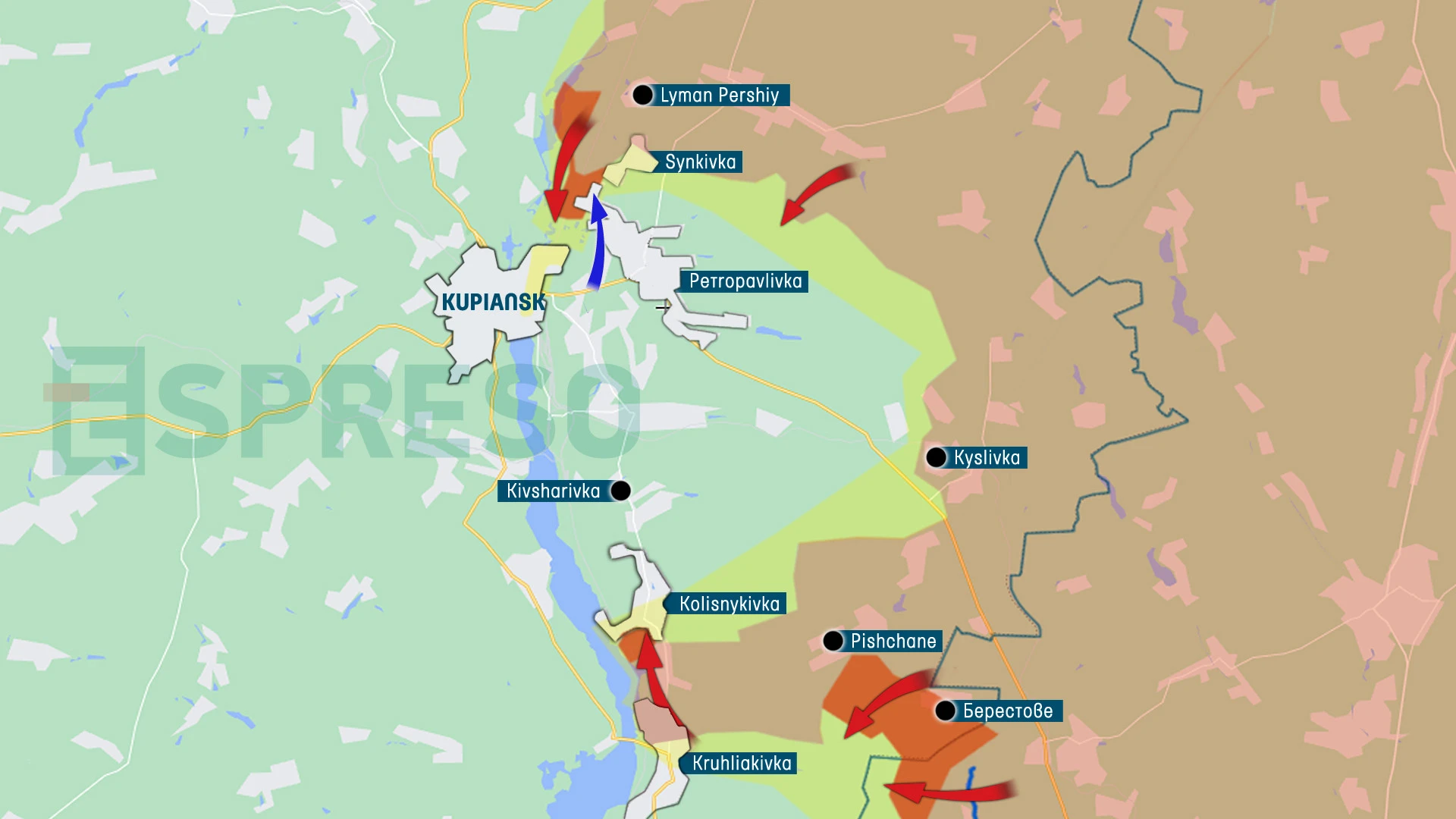
On the southern flank of the Kupyansk front, Russian paratroopers took control of Kolisnykivka but failed to advance on Hlushkivka. Their attempts to push south of Kruhlyakivka toward Borova also went nowhere. Meanwhile, the Russian control zone along the left bank of the Oskil River in the Senkove area now spans more than 3 km. Russian forces are preparing for a major offensive, aiming to seize the northern bridgehead of the Ukrainian Defense Forces on the Oskil’s left bank by year’s end.
After occupying Berestove, the Ukrainian Armed Forces withdrew to avoid encirclement. Russians took over the positions but failed to advance further west.
Kursk front: Circular defense
The Russian counteroffensive in the Kursk region has been dragging on for two months, with little to show for it except burned equipment. The Kursk front stands as a model of modern combat, where elite brigades on both sides face off. Despite being outnumbered by at least five to one, the Ukrainian Armed Forces are conducting a stellar defensive operation and even launching counterattacks.
Russian forces saw their biggest gains on the right flank, finally entering Plekhovo after a month of fierce defense by Ukrainian troops. They expanded their control northward, taking Pushkarnoye, Ruskaya Konopelka, and Kruglik, and are continuously attacking positions near Nechayevo.
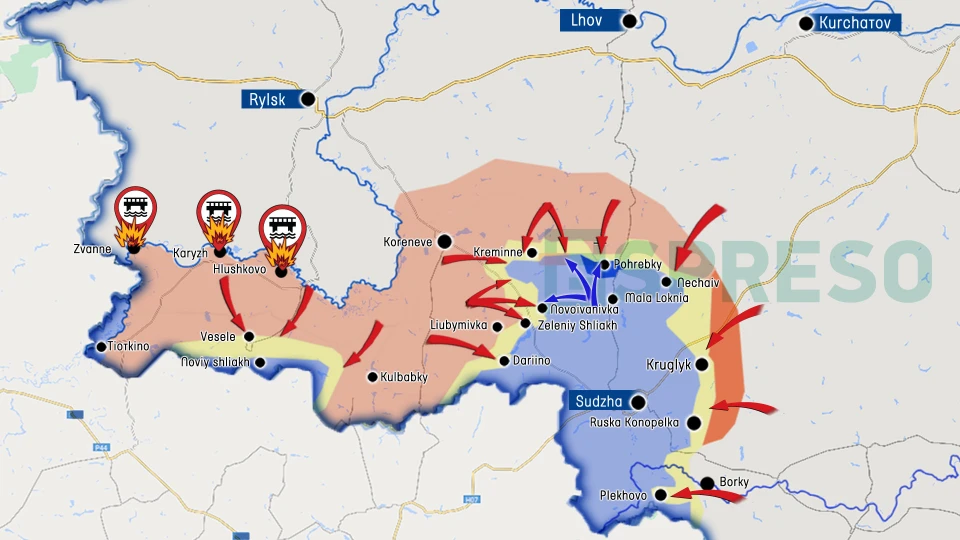
Ukrainian forces, however, retook lost ground near Pogrebki and wiped out a Russian detachment attempting a counterstrike.
Near Olgovka, Ukrainian troops found themselves in a semi-encirclement but managed to retreat with dignity and secure new positions. Russian forces crossed the Snagost River near Dariino, where fighting continues. However, their key offensive direction — toward Malaya Loknya and the Sudzha highway — has stalled for weeks. They remain bogged down in heavy fighting near Novoivanovka and Zeleny Shlyakh, suffering massive losses in the process.
Meanwhile, Ukrainian forces deployed long-range ATACMS missiles for the first time, destroying a military base in the Bryansk region.
The maps were created using information from the General Staff of the Ukrainian Armed Forces and other verified open sources. They are not perfectly precise but provide a general picture of trends in the combat zone.
- News





